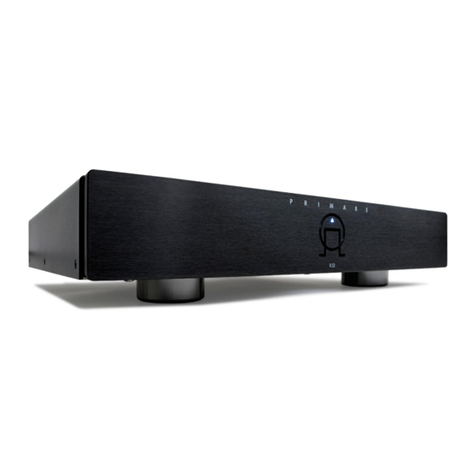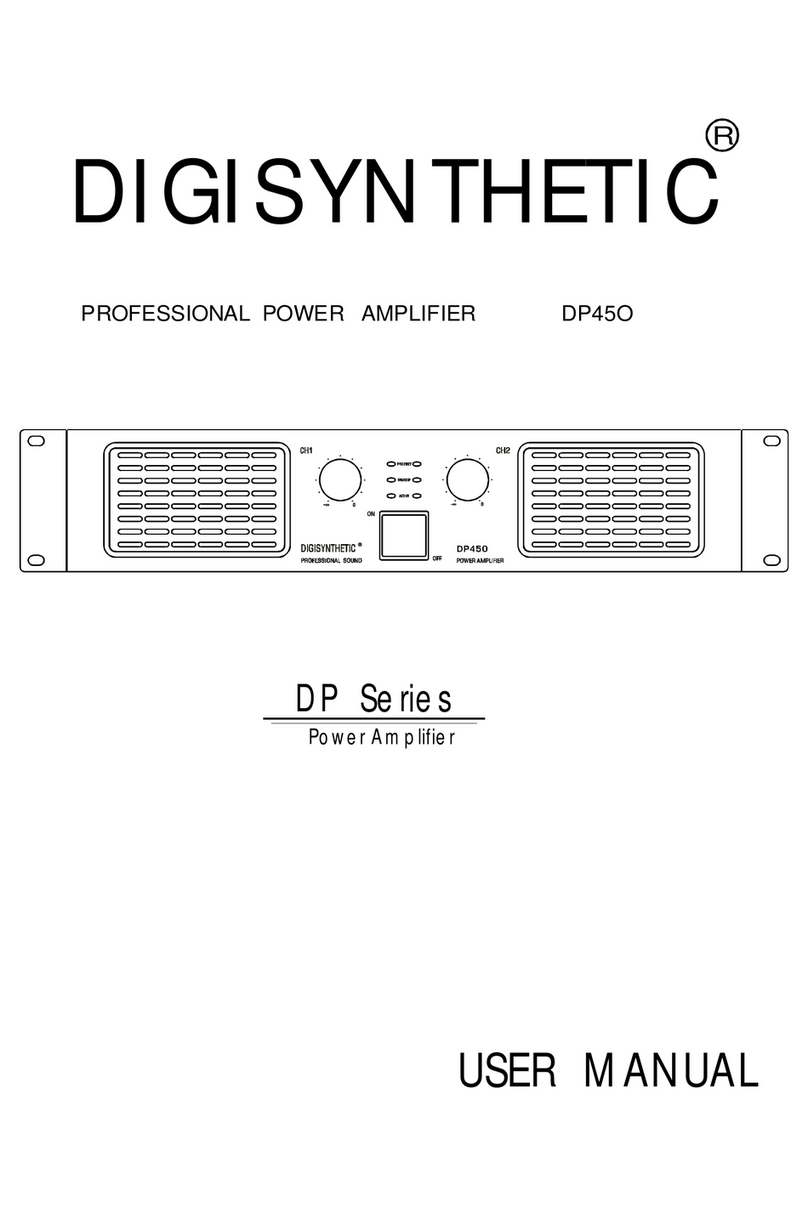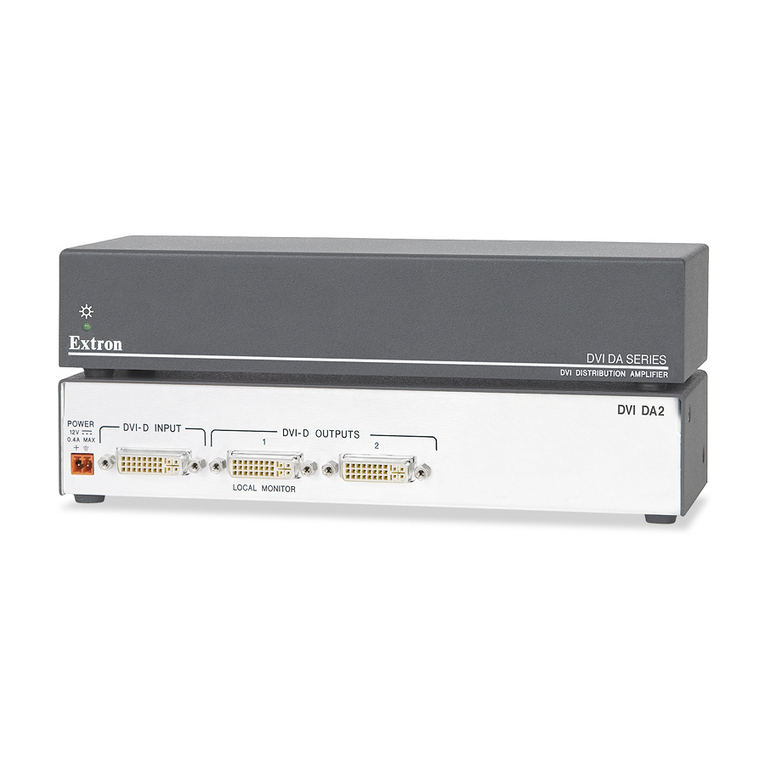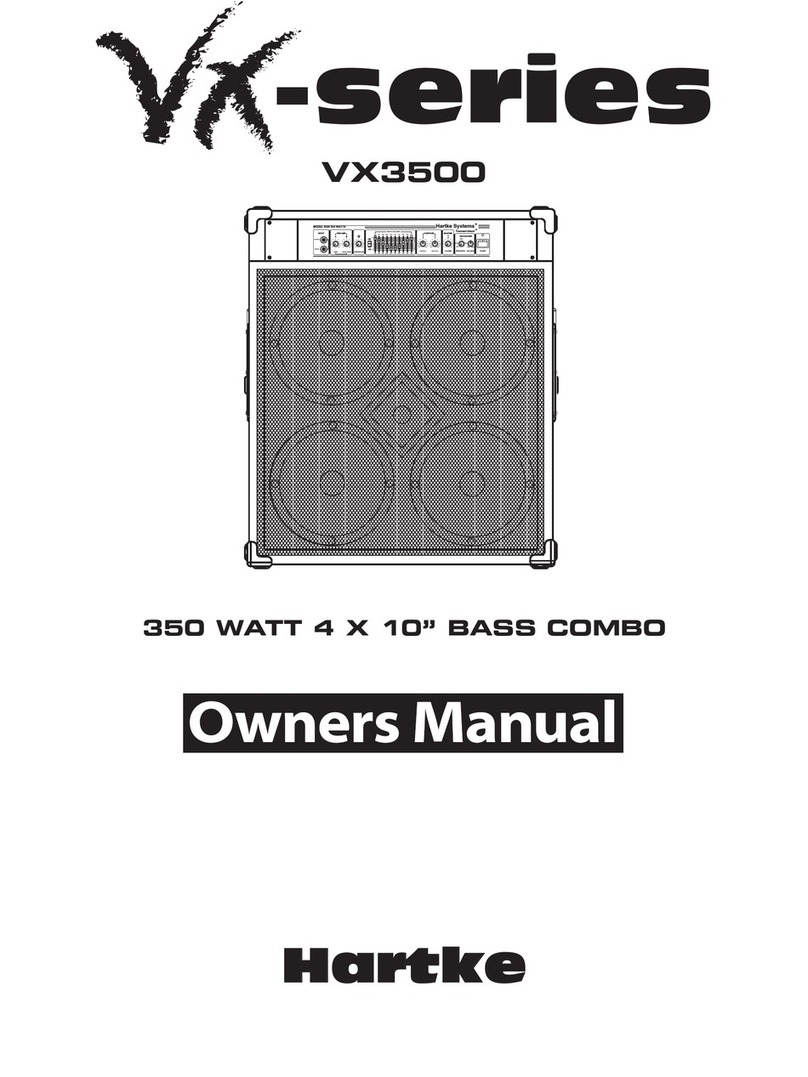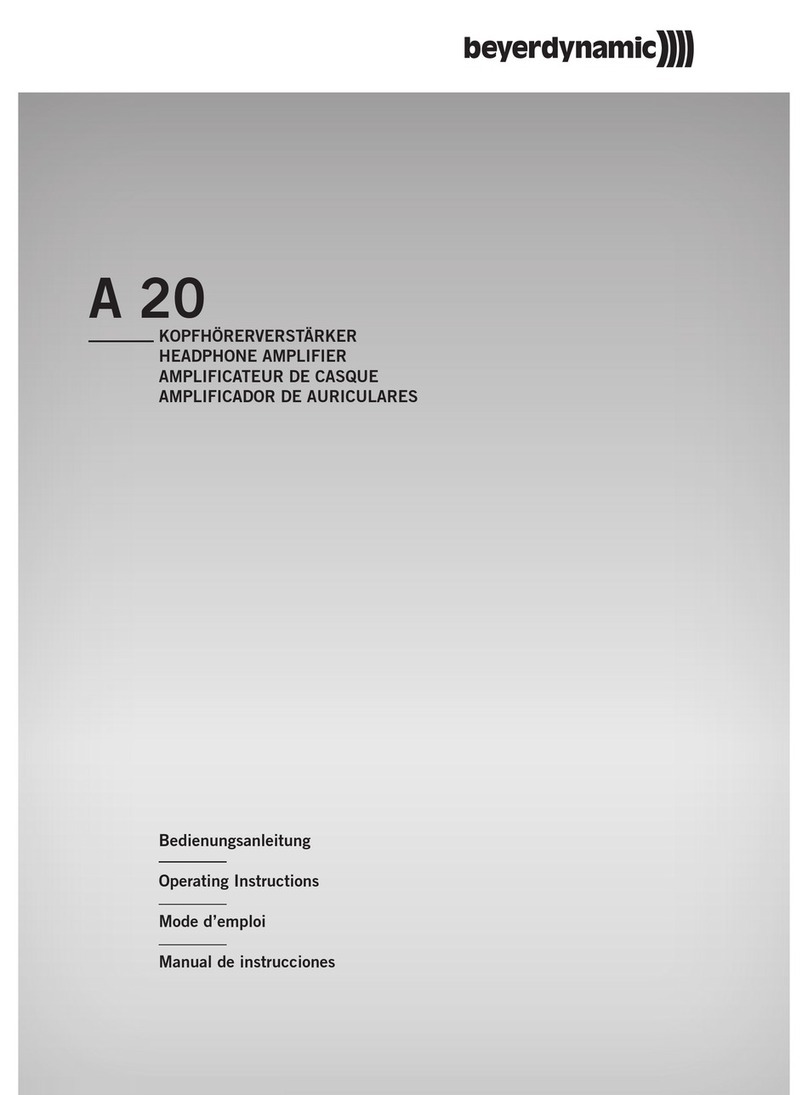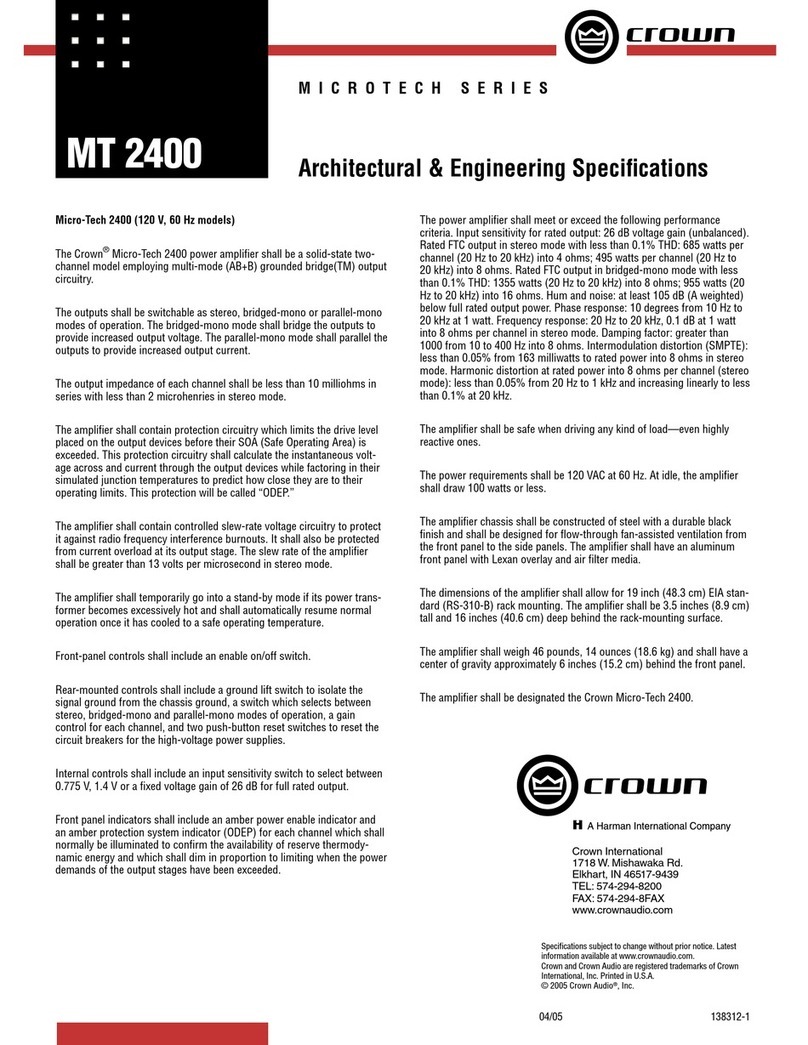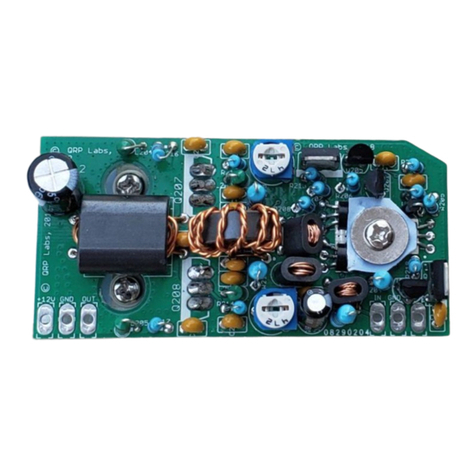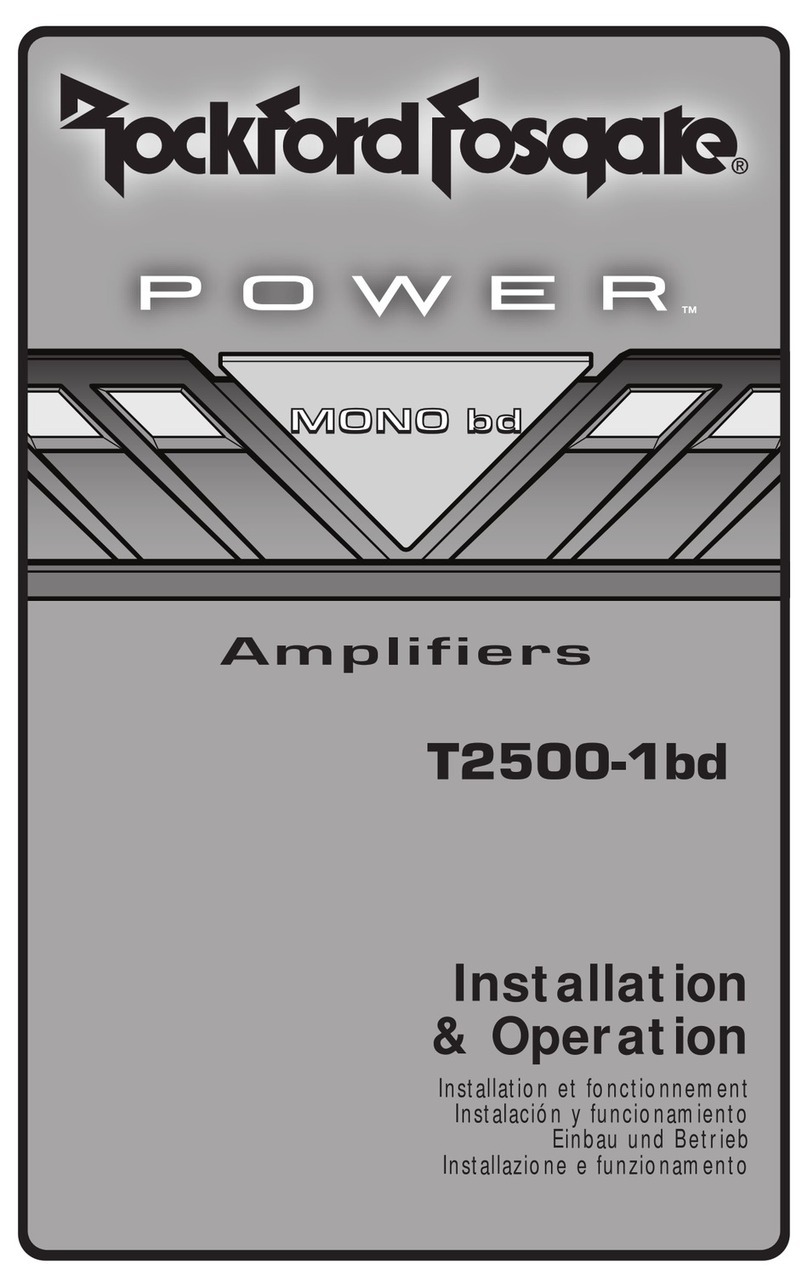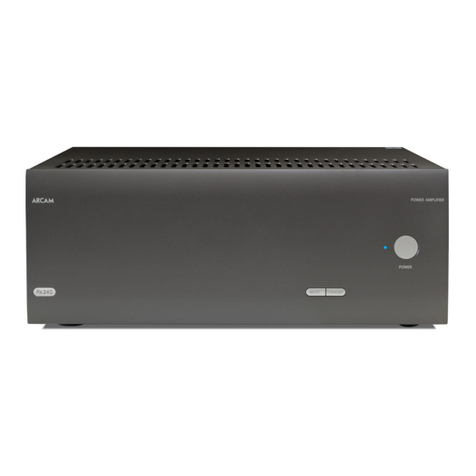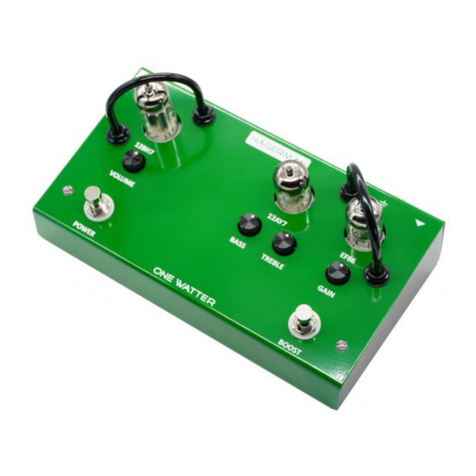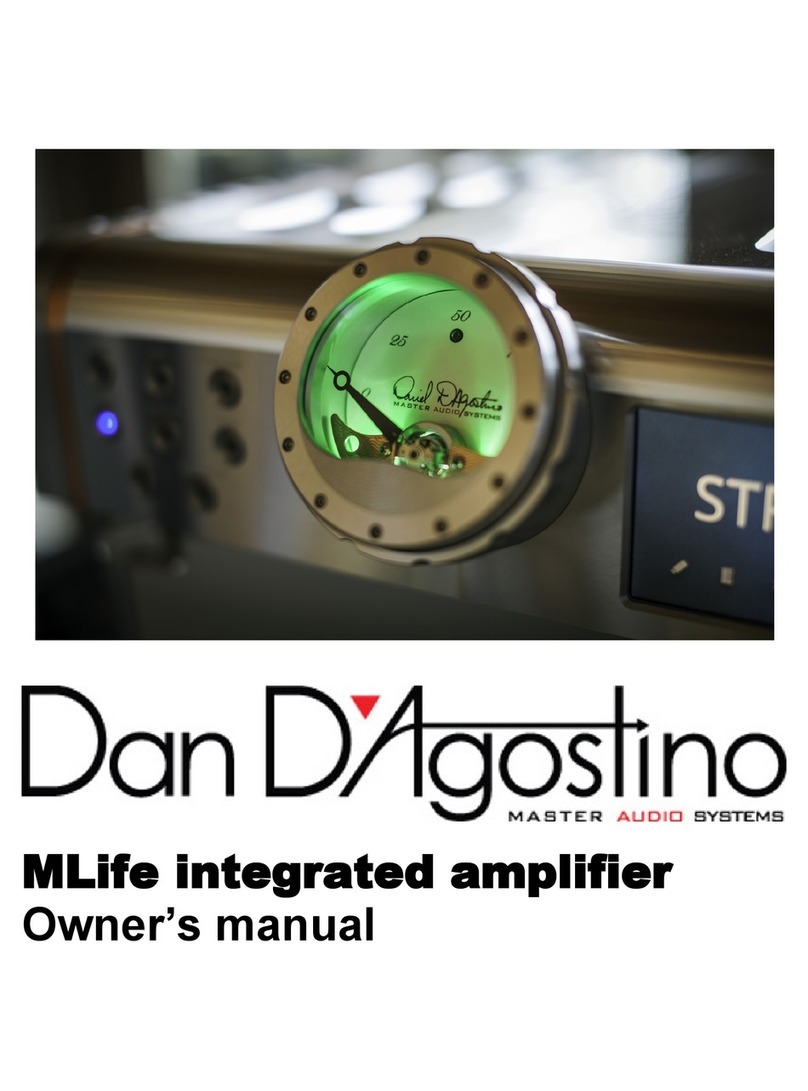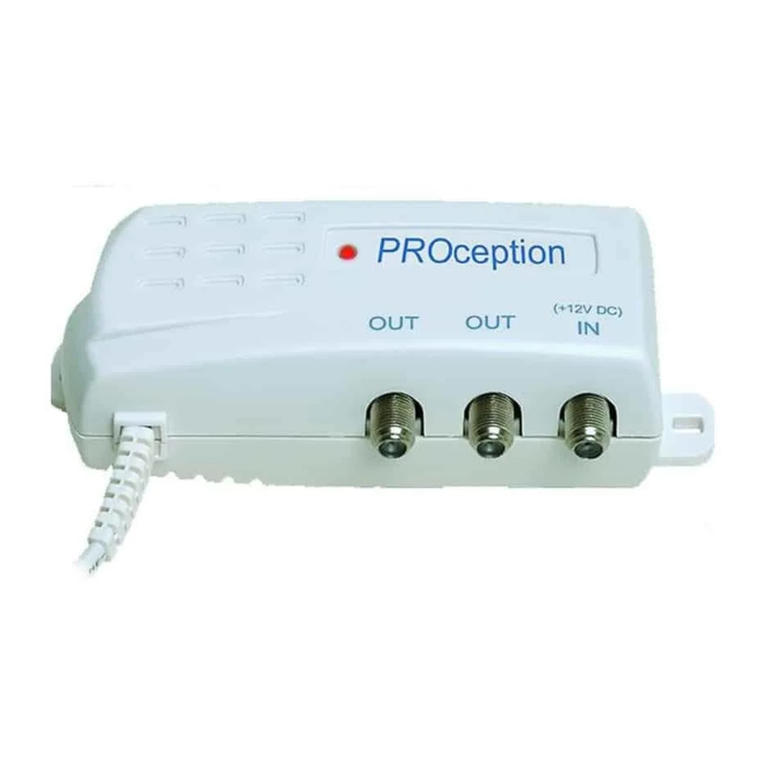David Berning 211/845 User manual

OWNER' S MANUAL
THE DAVID BERNING COMPANY
211/845
POWER AMPLIFIER
The David Berning Company
12430 McCrossin Lane
Potomac, Maryland 20854
USA
(301) 926-3371
www.davidberning.com
WARNING: For safety, the cover of this amplifier should be secured at all times. DC
voltages as high as 1700 V and peak ac voltages as high as 3000 V are present inside.
The service information in this manual is intended for trained service personnel.
Furthermore, this amplifier generates radio-frequency energy that can interfere with
communications equipment if the cover screws are not tightly secured.

2
WORLDWIDE DISTRIBUTION
Hi Fi One
Rick Brown
6978 Corte Langosta
Carlsbad, California 92009
(612) 817-1599
The Basics
The 211/845 is a monoblock amplifier that can deliver enough power to loudspeakers to
cause damage if cable grounding is faulty. It is important to make sure that interconnect
cables are in good condition and the ground is firmly secured to the input jack before
powering up the amplifier. The 211/845 can be energized without a speaker or
interconnect cable connected.
It is very important to pay close attention to the power line connections in your system
and to prepare properly for achieving low noise in your system. These amplifiers
incorporate soft start and can be operated from a single incoming power feed in your
system. It is desirable to feed your entire system from a single power feed to minimize
the chance of ground loops. If you have a cable connection that is used for radio or TV
and you have these providing audio for your system, there is a potential for a ground loop
that results in hum. If this is the case, you may need to get an RF isolator transformer for
the cable to break the grounds. These are inexpensive devices and a worthwhile
investment. If you find that you have hum after powering up your system, you can
troubleshoot the system by removing component interconnects until the hum goes away.
Then you need to re-evaluate why there may be a problem with grounding on that
component. Some power cords have a faulty design that results in hum from radiating
loops. Cheater plugs that break grounds are not recommended for permanent installation
for large amplifiers such as the 211/845.
Both single-ended and balanced input connectors are provided. A toggle switch near the
connectors is used to select for balanced or single-ended inputs.
Unpacking and Repacking for Shipping
Your amplifier is shipped with the smaller tubes installed. The large 211 or 845 output
tubes are not shipped with the amplifier and are ordered, curve traced and shipped
separately. The 211/845 amplifier is unusual in that it can be operated with either choice
of these tubes. The two tubes are not equivalent and will result in somewhat different
amplifier characteristics. Once installed, the amplifier will automatically adjust itself to
accommodate either tube set. To install the tubes, note the pin on the side of the tube and
lower it into the socket with the pin dropping into the slot, and once it drops down all the
way, carefully rotate the tube clockwise about 45 degrees to where it stops. Make sure

3
the pin moves into the guide slot as it is rotated. Do not force it as it should turn
moderately easily once it is in the guide slot. Rotation of the tube depresses the four stiff
contact springs in the socket. To repack for shipping, reverse the process.
Components are included in the amplifier packaging for a safety cage to protect the user
against the hot output tubes, and to protect the tubes from being struck and broken. If an
unprotected tube is struck and broken by a metal object, that object may become
electrified with a couple of thousand volts! These components need to be assembled
into a structure that offers the required protection and lets the heat out. The assembly of
the safety cage is shown in Figure 1. Make sure that the power cord is removed as one
of the components may fall into the tube opening and need to be retrieved. Remove the
four screws that fasten the decorative tube ring to the top of the chassis and set them
aside. Leave the ring in place, and build the pictured structure one level at a time using
the standoffs and additional tube rings supplied. Start with the bottom layer as you
cannot assemble the structure from the top and later attach it to the amplifier cover. You
should make all four levels to have the top plate well above the tubes. If you use only
three levels, the top plate will get dangerously hot. Finally, install the four screws
through the top solid plate and into the top standoffs. To change the tubes, you need only
remove the top plate as you can reach through the tube rings. The safety cage must be
completely disassembled to reship the amplifier. The tube cage does not need to be
removed for removal of the main chassis cover, but in order to turn the amplifier upside
down for easy access to the screws it will be best to support it with some books or similar
objects so as not to rest the weight on the cage.
Your new amplifier is enhanced with Stillpoints TM Ultra 5 feet that are shipped in a
separately box from the amplifier shipping carton. Four Ultra 5s are used per mono
amplifier and must be attached prior to use. They will serve as the isolation interface
between the bottoms of the amplifiers and surface you rest the amplifiers upon. Unpack
the Ultra 5s and screw the provided ¼-20 stud into each Ultra 5 with a hex wrench and
tighten. Then hand turn each Ultra 5 assembly into the Stillpoints TM Ultra Base units that
are permanently mounted to the underside of each amplifier. Do not turn the Ultra 5s in
so far as to touch the Ultra Bases. The Ultra 5 and the Ultra Base are designed to work
optimally with a little bit of the stud visible. Rotate the Ultra 5’s until the amps are level
and the weight is evenly distributed. To ship the amplifier, the Ultra 5s must be removed
and shipped separately.

4
Fig. 1. Sketch of assembly of safety cage.
Tube Rolling and Cover Removal
The 211/845 has its power supply and impedance converter in a shielded enclosure
within the main chassis of the amplifier. This enclosure offers partial protection from
high voltage, as the tubes and the AC line switch are not within this enclosure. 1700 volts
dc and peak ac voltages as high as 3000 volts are present at the base of the output tubes.
It is therefore very important that the outer chassis cover be secured at all times
when the power cord is connected. Before removing the chassis cover, the power
cord must be detached from the amplifier first.
Both the output tubes and perhaps some of the smaller tubes can be removed and changed
without actually taking the main cover off of the amplifier. To do so, reach into the
opening that the output tubes are normally placed. But as the case with removing the
chassis cover, the power cord must be removed before reaching into this opening.

5
To remove the cover, the 211/845 must be turned upside down. The screws holding the
cover are located along the side edges, four on each side. It is important to note that
these screws thread into aluminum, and can easily become cross-threaded when
reinstalled. It is recommended that the screws be started with a very small screwdriver,
or preferably just with fingers, to limit the amount of torque applied until it is certain that
they are not becoming cross-threaded. The 211/845 is auto-biasing for either tube set;
therefore the tubes can be changed without the need for manual bias calibration.
Both the 211 and 845 tubes were developed many years ago as linear modulators for
radio transmission and audio amplifiers. They are both triodes and are noted for their
high degree of linearity. The differences between these two tubes allow the user to
optimize his or her audio system by choosing the best one for particular speakers and
acoustical environment. And this choice allows the user to change speakers and
reevaluate that choice rather than change amplifiers again to find the optimum match.
The 211 tube has higher gain than the 845, and higher output impedance. The 211/845
amplifier does not use a global feedback loop, and thus the output impedance of the
amplifier is proportional to the output impedance of the tubes used. This affects speaker
damping and thus the transient characteristics of the speaker. It is difficult to predict the
preferences a given listener will have with a given speaker in a given acoustical
environment as the damping of the speaker is changed. In terms of bass response it is
relatively easy to give some guidelines, but for higher frequencies it is harder. For bass,
higher damping, corresponding to lower output impedance, produces a tighter and dryer
sound. Low damping gives a more resonant and open sound. If you want tight bass, think
845, and think 211 for a more resonant sound. Of course, the mids and highs are
important, and final tube judgment must be done with all things considered.
There are two choices in the driver tubes for the 211/845 amplifier. The 6K6 is a true
power pentode, and the alternative tube choice is the 6V6 which is beam-power tube.
Two of either of these tubes are used. Both of these tube types have been around for
many years, but only the 6V6 is available as current production. Both are easy to find as
new old stock (NOS). The 6V6 is a little more powerful and the amplifier specifications
are given as tested with the 6V6. Power output is about 10% less at a given distortion
level when using the 6K6. Your amplifier is supplied with 6V6s.
It is recommended that two 211 tubes or two 845 tubes be used, and not one of each. The
amplifier will work with one of each, but the 2nd harmonic distortion component is about
10%. While the use of one 6K6 and one 6V6 does not result in such high distortion, some
increase in distortion could be expected.
Operation and Features
Connect the signal source and the speaker cables to the input and output on the 211/845.
For a balanced (XLR) input cable the BAL/UNBAL switch located on the back should be
set to the BAL position; alternatively, if a single-ended RCA-type cable is used, the
switch should be set to the UNBAL position. Connect the 211/845 to the ac power mains

6
with the supplied power cord or similar IEC-terminated power cord. It is generally not
desirable to use a power conditioner as both a surge suppressor and a five-stage line filter
are built into the 211/845.
Turn the power switch on (located on back). The auto-bias light should change from red
to a mostly green after about 75 seconds for 845 tubes and 100 seconds for 211 tubes,
after which the 211/845 is properly biased and ready to play.
Your 211/845 amplifier can handle difficult load impedances. Momentary shorts or opens
at the output of the 211/845 will not damage the amplifier; however, a sustained short
circuit at the output may cause overheating, and may cause the amplifier to shut down.
Auto-biasing
Once the 211/845 is turned on, an auto-bias sequence begins that gradually raises the bias
current in the output and driver tubes that is designed to prolong life and reduce turn-on
transients that could otherwise be fed to the speaker. Tubes of the 211 and 845 types are
directly heated and thus have very quick warm-up times. If the driver-stage voltages are
not carefully controlled during warm up, dc transients will generally develop. Also, if
operating voltage is fed to the tubes before the heaters are up to their recommended
operating temperature the cathodes can be stripped of their emissive coating. These
carefully programmed procedures dictate the wait time before the amplifier can be
played. Proper bias is established when the bias light changes to mostly green.
If the amplifier is played before proper bias is established, it will temporarily sound
distorted but will still auto-bias. During the biasing procedure or after biasing is
completed, this light can indicate failure of a tube by remaining red or abruptly going
back and forth from all red to all green, especially if associated with popping sounds
from the speaker. Tube failure causes various protection circuits in the 211/845 to shut
down the power supply to avoid damage to the amplifier or the speaker, and the auto bias
is tied into this function. If the power supply shuts down, it may be necessary to reset it
by turning off the power and waiting five minutes and turning it on again.
Changing the CLASS switch makes the auto-bias light momentarily change to red or all
green, depending on whether the bias current is being increased or reduced.
Class of Operation
A three-position switch marked CLASS A is included on the front panel of the 211/845.
This switch can be changed on the fly. It affects the amount of idle current in the output
tubes. Technically speaking the amplifier runs in class A for any of these positions, but
does so in an increasingly less-linear manner as the switch is moved from FULL to
PARTIAL to CONSERVE. Unlike Class AB or Class B amplifiers, neither output tube is
completely cut off unless hard clipping occurs. But in the lower bias current modes there

7
is an increasing dependence on having only one of the output tubes controlling the
linearity.
When there is higher bias current there is a larger region of dual linearity, and there is
less generation of higher-order harmonic distortion products, particularly at higher power
levels. For the most critical listening at higher power levels, the FULL mode provides the
purest sound reproduction and the CONSERVE mode is the logical choice for less
critical listening, or listening at lower levels. However, you should evaluate the sonic
merits of listening critically at the various settings. You may overestimate the amount of
power you need and the CONSERVE or PARTIAL modes may not compromise the sonic
purity in your situation. Also, the output impedance is different for the different modes
and this generally does affect the sound.
The 211/845 follows other Berning designs in that the tubes are operated at relatively low
temperatures for long life. The exception is the operation of the output tubes if the FULL
CLASS A mode is used. However, these tubes are designed to provide long service life
when operated hot. The idle plate-dissipation for each output tube is 71 watts in the
FULL mode; 37 watts in the PARTIAL mode; and 17 watts in the CONSERVE mode.
Added to this is a 30-watt heater, and hence these tubes run quite hot. Routine tube
replacement on the 211/845 should not be needed with normal usage. 10,000 to 20,000
hour lifetime should be expected. Additionally, it is recommended that the amplifier be
powered down when it will not be used for several hours or more, otherwise it can be left
powered. If the FULL CLASS A or PARTIAL mode is used in listening, switching to
CONSERVE mode can be done to place the amplifier into a quasi-stand-by mode if there
is a break in listening for a period of time.
The output impedance of your 211/845 amplifier can vary from 1.7 ohms (moderately
high damping) to 5 ohms (moderately low damping), depending on the tube choice and
CLASS setting, as detailed in the Specifications section. This provides a rather wide
range of speaker damping characteristics.
While many amplifiers have a large amount of negative feedback to achieve high
damping, this is not always optimum. The impedance of most speakers varies with
frequency. Often this shows up most dramatically with a rise in impedance near the bass
resonance frequency. When an amplifier has relatively high output impedance, coupling
more power into the speaker at those frequencies where the impedance is higher changes
the system frequency balance. Speaker designers generally try to design for a flat
frequency response using an anechoic chamber. Home listening environments generally
fall far short of the ideal acoustic properties of the anechoic chamber, and the tube choice
and/or CLASS switch gives you, the amplifier user, a means to modify the normal
speaker response to compensate for room acoustics and personal preference.
Technically, speaker damping relates to the control that the amplifier has over the
position of the speaker diaphragm. High damping applies tighter voltage control over the
speaker and causes the amplifier to absorb and stop speaker cone motion due to the
(speaker cone) overshooting its desired position in response to transients. However, many

8
speakers are somewhat over damped by design and rigid voltage control is not optimum.
As the output impedance of the amplifier is raised, this reduces the tightness of the
voltage control and applies a mixture of current and voltage control. If the speaker is over
damped, the cone will not reach its proper position quickly in response to a transient. If
the speaker is underdamped, the cone will overshoot its desired position and will ring.
With the right amount of damping, the speaker cone will neither overshoot nor
undershoot its desired position. This is often termed critical damping. High damping is
likely to give a tighter, dryer, and more analytical sound, and low damping is likely to
give a more open and resonant sound. The sonic attributes of damping show up most
dramatically in the bass.
Other Features
Stillpoints TM isolation standoffs are used to mount the power supply board to its shielded
enclosure and also to mount the hand-wired audio panel. These provide a significant
degree of decoupled isolation for the amplifier subassemblies.
Like other recent Berning products, the 211/845 incorporates a fully regulated, resonant-
type, switching power supply. The use of regulated switching power supplies in Berning
amplifiers over the years has resulted in a reputation for having better control in the bass
than tube amplifiers with conventional power supplies. The use of these supplies has
also resulted in unusually lightweight and compact amplifiers for their power capability
because there was no line-frequency power-transformer in these units. Traditional
thinking found it difficult to believe that improved bass reproduction could be obtained
with a lighter-weight design.
Active line power factor correction (PFC) is used in the 211/845. This extra full power-
processing stage in the power supply allows the amplifier to meet worldwide line
harmonics emissions standards. This means that the amplifier does not draw power from
the line in sharp high-current pulses, but in a more even sinusoidal fashion. The sonic
benefit is less disturbance of the power line that can affect other components in your
system and thus they can work at their best. PFC also pre-regulates the power going into
the main regulator in the power supply, thus the amplifier’s performance is not affected
by line voltage. The line voltage input is universal and can be 90 VAC to 240 VAC
without changing anything.
The audio circuit is hand-wired on a metal panel to prevent normal circuit board-related
parasitics in dielectric properties from degrading the sound reproduction. Premium
quality Caddock resistors and Teflon capacitors are used.
Other features include:
Both single and balanced input, all balanced amplification.
No loop negative feedback, no phase compensation used.
Constant output impedance over entire audio spectrum.
Built-in five-stage power-line filter and surge suppressor.

9
Non-magnetic chassis prevents skin-effect induced distortion.
Power supply in separate internal shielded enclosure.
Specifications
Power consumption: 150 W to 500 W
Line voltage required: 90-240 VAC, 50-400 Hz.
Signal to noise: broadband (typical) 50 dB, all Class settings. 20 kHz bandwidth
(typical): 86 dB 845 FULL; 90 dB 845 PARTIAL; 92 dB 845 CONSERVE; 83 dB
211 FULL; 86 dB 211 PARTIAL; 86 dB 211 CONSERVE. All figures unweighted.
Distortion (typical, at 8 ohm loads at 50 W): 0.3% 845 FULL; 0.5% 845 PARTIAL;
1% 845 CONSERVE; 1% 211 FULL; 1.5 % PARTIAL; 1.7% CONSERVE. These
may up to double at 4 ohms.
Typical output power at onset of clipping (3% distortion): 8 ohms 84 W 845; 8 ohms
72 W 211; 4 ohms 110 W 845; 4 ohms 72 W 211. 6V6 driver tubes installed. 6K6
driver tubes result in about 10% less power capability.
Frequency response at 50 W, 8 ohms: +0, -3 dB 60 kHz all tube combinations, FULL mode.
+0, -1 dB 30 kHz all modes and all tube combinations. Frequency response at 50 W, 4 ohms:
+0, -3 dB 50 kHz all tube combinations, FULL mode. +0, -1 dB 27 kHz all modes and all
tube combinations.
Full power low-frequency limits: 8 ohms < 1 dB down @ 5 Hz, speaker protection activated
@ 4 Hz 50 W; 4 ohms < 1 dB down @ 10 Hz, speaker protection activated @ 8 Hz 50 W, all
modes and tube combinations.
Output impedance (measured at 1 amp, 60 Hz): 1.7 ohms 845 FULL; 2.3 ohms 845
PARTIAL; 3.3 ohms 845 CONSERVE; 2.7 ohms 211 FULL; 3.5 ohms 211
PARTIAL; 5 ohms 211 CONSERVE.
Single-ended or balanced end-to-end input sensitivity for 50 W: 0.93 VRMS 845
FULL: 0.97 VRMS 845 PARTIAL; 1.0 VRMS 845 CONSERVE; 0.5 VRMS 211
FULL; 0.52 VRMS 211 PARTIAL; 0.56 VRMS 211 CONSERVE. Individual tube
gains will affect these numbers, but the trends are valid for all tubes.
Gain: 26 dB for 845 tubes; 31 dB for 211 tubes.
Input impedance: 50 k
Watchdog speaker protection characteristics for tube failure: Initial fast 4A 300ms 6Ω
speaker 29 Joules plus extended slow 1A 10s 6Ωspeaker 60 joules. (100 Joules
would represent the heating of the bass driver voice coil if a 10-watt RMS signal was
applied at low frequency for 10 seconds). Other driver impedances would absorb
similar energy.
Main case size: 48 cm wide, 48 cm deep, 20 cm high, (19 X 19 X 8 inches), including
connectors and feet. Output tube cage adds 10 cm (4 inches) to height if used. Tubes
extend 5 cm (2 inches) above main case.
Net weight: 17 kg (36 lb); Boxed, 19 kg (42 lb).
Finish: silver anodized aluminum
Limited Two-Year Warranty *

10
1. Your new Berning product is covered by a limited two-year warranty against defects
in material and workmanship. Any repairs required will be made at no charge within the
first two years after purchase as a new unit.
2. Any units returned for warranty repair must be shipped prepaid after receiving return
authorization from the David Berning Company. For safe handling, and if at all possible,
the unit should be shipped in its original carton. If such is not possible, the unit should
be well packed with particular attention paid to protection of all corners and avoidance of
any looseness in the carton. If desired, a new shipping carton can be purchased from the
David Berning Co. The David Berning Co will pay return transportation within the
United States of America. Hi Fi One, the worldwide distributor will pay return
transportation outside the United States of America.
3. This warranty does not apply to damage resulting from physical abuse or unauthorized
alterations or repairs; or damage to exterior finish resulting from careless use. The
warranty is void if the serial number has been removed, altered, or defaced.
4. The David Berning Co. reserves the right to improve or change its products without
obligation to modify previously manufactured units.
Appendix – Nuts and Bolts for the Technically Curious and Service Personnel
Circuit Topology
The input stage of the 211/845 amplifier is a differential 12AT7 with a bipolar transistor
current sink. This stage provides the first gain and precisely balances the input into two
balanced outputs. The input is terminated with 50k and dc coupled. The outputs are
coupled through a pair of Teflon capacitors to the input grids of a differential 6SN7 stage,
also using a bipolar transistor current sink. The current sink assures that the two outputs
from the 6SN7 are precisely balanced.
The outputs from the 6SN7 are dc-coupled to the grids of the power pentodes (6K6) or
beam tetrodes (6V6). These tubes are operated as voltage followers, but in an unusual
pentode mode. Each of these tubes has its own floating, very low parasitic capacitance
screen power supply, possible only with a high-frequency switching power supply such
as in the 211/845 amplifier or a battery. The high sides of these supplies are bootstrapped
back to feed power to the 6SN7. Also feeding power to the 6SN7 plates is a servo-
controlled voltage source that is controlled by measuring the combined cathode current of
the output tubes. The bootstrapping technique combined with the pentode followers
provides very low distortion drive to the output tubes with up to 600 volts peak to peak.
One of the grids of the 6SN7 also receives a dc offset balance signal which is another
servo circuit designed to prevent dc offset at the speaker while balancing the output stage
and maintaining dc coupling throughout the remainder of the amplifier.
The cathodes of the 6V6/6K6s are dc coupled to the output tubes, and the output tubes
are dc coupled through the patented Berning ZOTL twin impedance converter modules.

11
The dc coupling is important in that allows amplifier overload or clipping without
recovery issues that plague ac-coupled stages. This means that the amplifier can be
driven quite hard into clipping without it being apparent. Also note that no loop feedback
is used, and this greatly improves the amplifier’s ability to recover from overload.
There are several circuits that offer both amplifier and speaker protection in the event of
a component failure. There is a relatively slow-acting dc-offset protection circuit that
shuts down the power supply if dc is detected at the speaker terminals. This circuit
protects against moderately low dc voltages that may appear for a longer time and would
gradually heat the voice coil. The time to shutdown is proportionate to the amplitude of
the dc voltage.
A special current-imbalance sensing transformer in the power supply overrides the
slower voltage dc-error-sensing at the amplifier output if a large unbalanced dc current is
detected in the power supply, indicating a large dc current in the speaker. This extra
protection is included to protect the speaker in the event that a tube or other component in
the signal path should fail catastrophically. This protection places the power supply in a
fold-back mode. The speed of this circuit is chosen to allow full amplifier power to be
delivered at very low frequency, but not too low. The trigger points are 8 Hz at 50 watts
with 4 ohm loading, or 4 Hz 50 watts 8 ohm loading. This circuit has a 1-amp dc trigger
point. The combined effects of these watchdog circuits result in an example 6Ωspeaker
being subjected to joule heating of the bass driver voice coil that is limited to 4 amps for
300 ms, followed by 1 amp for 10 seconds. This heating is 29 J + 60 J. For comparison, if
a 10-watt RMS low-frequency signal was applied for 10 seconds, this would represent
100 J.
It should be noted that none of these protection circuits are in the audio signal path or act
as the result of any instantaneous output condition. Like other tube amps, a momentarily
shorted output will not hurt the 211/845, and a momentary short will not activate the
protection circuits. Note that this imposed limit does not introduce distortion or phase
shift at 20 Hz.
The power supply of the 211/845 amplifier begins with an active power factor correction
(PFC) circuit that is a pulse-width modulation (PWM) power converter. This circuit takes
universal line voltage and converts it to a regulated 375 VDC. The most important
feature of PFC is that it causes the line current to be drawn from the power line in a
sinusoidal fashion, thus keeping the generation of harmonics to a minimum. This is now
required for many of the worldwide standards for power supplies above certain power
limits.
The output of the PFC then goes into the main power supply converter/regulator. The
main power supply is a parallel-resonant converter that uses frequency control rather than
the more common PWM used in most switching power supplies. Berning adopted this
topology in the mid-1980s because it is inherently current limited and can charge
arbitrarily large banks of filter capacitors, important for good sound. It also uses soft
switching and applies a sine wave through the power transformer, cutting down on

12
generated noise. This supply runs at about 250 kHz, and this same frequency is used for
the impedance converter, cutting down on intermodulation products that would be
generated if an alternate frequency was used. The heaters of the output tubes are driven
with this same frequency ac with properly configured center-taped transformer windings.
The ac heating gives the proper transfer characteristic for the tubes whereas dc-heating
would not do this. The high frequency prevents audible hum that would be present if
heated with line-frequency ac.
The Zero-Hysteresis (ZH) 270--A New Kind of Amplifier, Now the 211/845
The design of the Berning ZH270 power amplifier and its release in 1996 represented a
radical departure from that of other amplifiers. The ZH270 was the first amplifier using
all-tube amplification to properly match the high-voltage, low-current operating
parameters of vacuum tubes to the low-voltage, high-current drive requirements of
dynamic loudspeakers without using audio-output transformers. The technology is
detailed in Berning US patent 5,612,646, and a simplified overview is given below. The
ZH270 has gained much respect for its transparency, versatility, and reliability, and has
enjoyed a production run of over 10 years. The ZH technology has also proven itself in
other recent Berning products as well.
Motivation for the Berning Technology
Audio-amplifier design engineers have long sought to eliminate the audio-output
transformer because of the restrictions that it has always imposed on amplifier
performance. Both leakage inductance and interwinding capacitance limit the high-
frequency response of the transformer, while core saturation and magnetizing current
limit its low-frequency response. Transformer-core hysteresis causes certain kinds of
distortion of the non-symmetric and transient waveforms so characteristic of musical
reproduction.
Tube Amplifiers have been previously made that drive dynamic loudspeakers without
output transformers. These amplifiers are called output-transformerless (OTL)
amplifiers. A well-known pioneer of this type of amplifier was Julius Futterman, and
there have been many amplifiers made by various companies over the years that are
based on the Futterman principles. The Futterman design incorporates two separate
banks of parallel-connected tubes. The two banks are joined in series by connecting the
effective cathode of one tube bank to the effective plate of the other tube bank, and
driving the loudspeaker in a push-pull fashion from this junction point directly without a
transformer. Popular alternatives to the Futterman use low-impedance triodes, but the
basic principals are the same. Given a sufficient number of parallel-connected tubes in
each bank, enough drive current can be obtained to drive the speaker.
There are several problems associated with the OTL amplifier that have limited its
application. The OTL amplifier is a “brute-force” methodology, whereby the banks of
tubes are forced to deliver the required drive-current often by high-feedback techniques.
The natural impedance of the cathode “push” is much lower than the plate “pull”, and

13
neither one is anywhere near the actual speaker impedance. In the Futterman style
amplifier, a large amount of negative feedback is required to force the push and the pull
to work together properly, and to provide sufficient damping for the speaker. Some of the
alternative OTLs that use the low-impedance triodes can operate without requiring
feedback because the gain of these triodes is so low that there is little difference between
the plate impedance and the cathode impedance, so the mismatch between the push and
the pull is minimal. However, even with the lowest impedance triodes available, there is
still a basic impedance mismatch between the tubes and the speaker in the OTL circuit.
The success of mating OTL amplifiers to dynamic speakers is very dependent on the
characteristics of individual speakers. Major reliability issues surround OTL amplifiers,
not only because a large number of power tubes are required, but also it is necessary that
the tubes need to be driven hard to obtain the required output current. Power
consumption is high for OTL amplifiers, often exceeding one kilowatt for a stereo pair.
Noisy fans may be needed in these amplifiers. Additional room air-conditioning may be
needed, further increasing the listening-room noise level.
The Berning ZH amplifiers take advantage of new technology in order to eliminate the
audio-output transformer. These amplifiers use radio frequency to change the voltage-
current transfer characteristics of the output tubes from their normal impedance-plane to
one suitable for driving a dynamic loudspeaker. The radio frequency re-mapping is
implemented using special high-frequency power conversion techniques. The high-
voltage, low-current tube impedance-plane is re-mapped to the high-current speaker
impedance-plane through a special transformer at a constant RF carrier frequency of 250
kHz. Because the audio signal is riding on a carrier, it is not subject to parasitic elements
of the transformer that would otherwise distort the audio signal. There is no low-
frequency limit for this impedance conversion, and these amplifiers can be dc-coupled if
desired, but in practice a means is provided to prevent dc from being fed to the speaker.
The impedance matching in the ZH amplifier is precisely determined by the effective
turns ratio of the RF conversion transformers. Both the push and pull portions of the
amplifier are handled in a symmetric fashion, as they are in a conventional transformer-
coupled amplifier, and negative feedback is not required to force the positive-output
current capability to be similar to the negative-output current capability.
Audio-output transformers have a limited impedance conversion range imposed by the
parasitic elements. Audio-output transformers also have limits imposed by voltage
breakdown between primary and secondary, and required insulation also affects the
parasitic elements adversely. It is difficult to make a high-fidelity transformer with much
more than a 25:1 overall primary-to-secondary turns ratio for the above reasons. These
restrictions are eliminated in the ZH amplifiers, and larger effective overall turns ratios
are applied to use the tubes more efficiently than they can be with the smaller ratios. One
implication of this change is the reflected plate resistance of the output tubes is lowered,
bringing the output impedance of the amplifier down.
Another implication of using a higher-effective turns ratio is that the output tubes operate
at lower current and higher voltage than they otherwise would. As tubes become weak

14
with age, the current capability is reduced, but the voltage capability is not affected.
Longer useful tube life is expected because less current is required for a given
output power. The opposite situation applies to the traditional OTL amplifier.
Audio-output transformer-coupled amplifiers should not be operated without a load
connected because the inductance of the transformer’s primary can cause the plate
voltage to reach a sufficiently high voltage to break down insulating materials, resulting
in amplifier failure and even fire. Some amplifiers are even unstable without a load.
Unlike output-transformer-coupled amplifiers, the ZH amplifiers can be operated safely
without a load, as the voltage cannot exceed its normal designed-in operating voltage.
Table of contents
